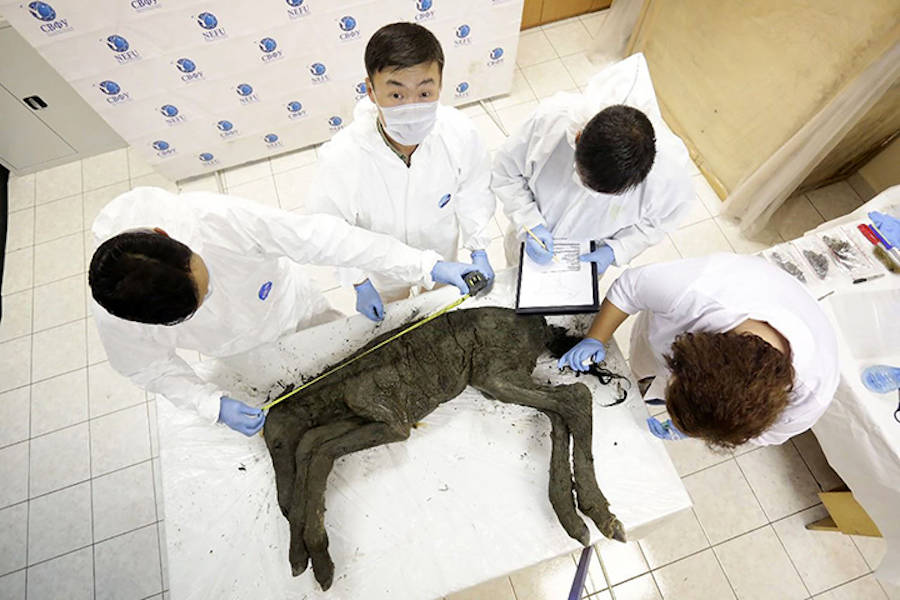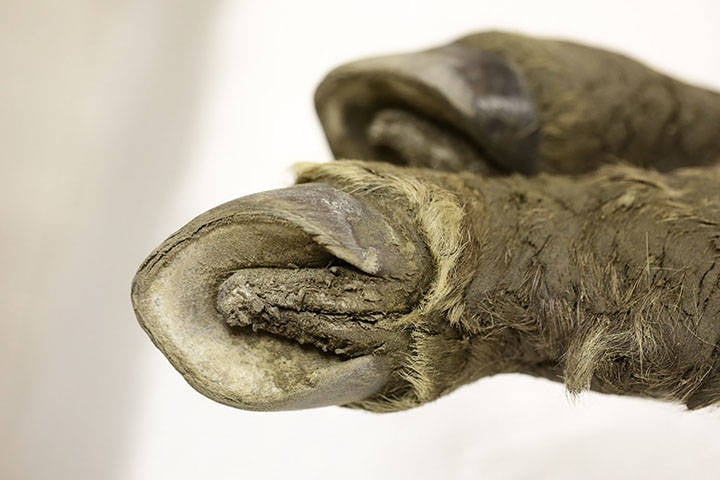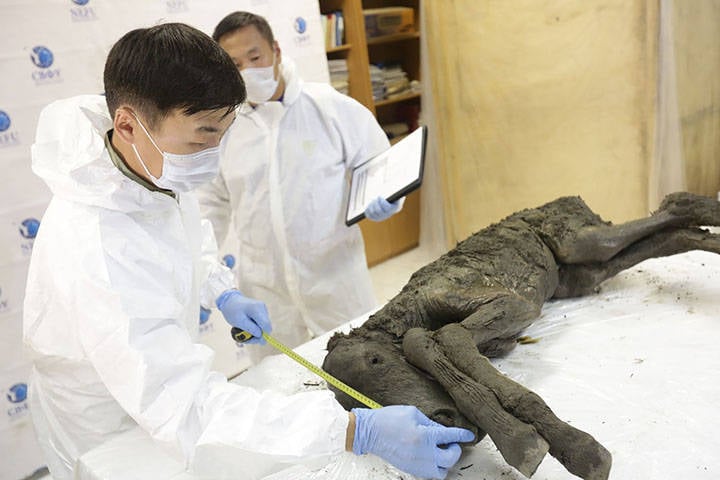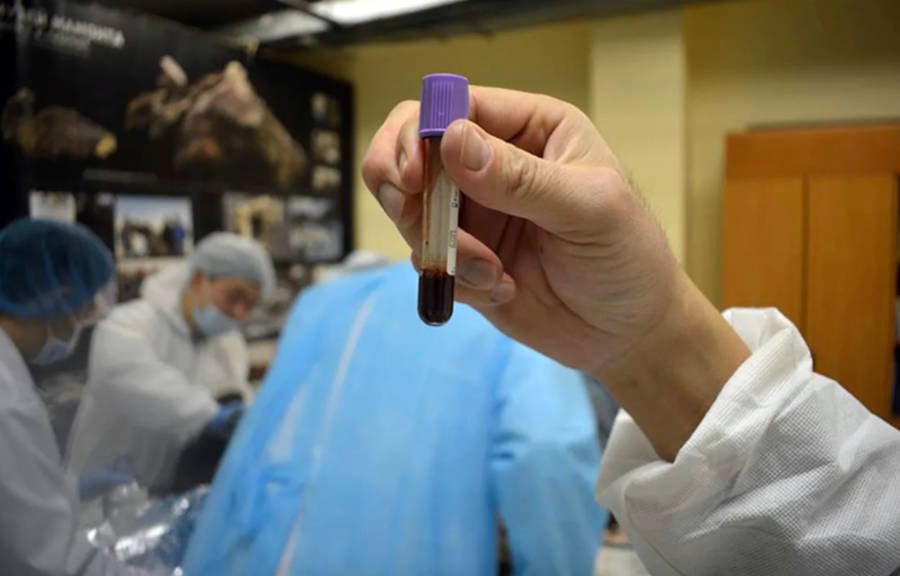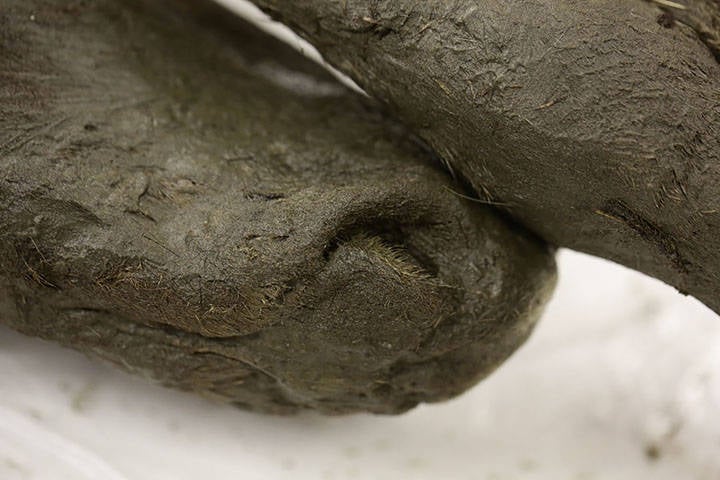
+- WildFact (https://wildfact.com/forum)
+-- Forum: Nature & Conservation (https://wildfact.com/forum/forum-nature-conservation)
+--- Forum: News, Events & Updates (https://wildfact.com/forum/forum-news-events-updates)
+--- Thread: Extinct Animals News (/topic-extinct-animals-news)
RE: Extinct Animals News - BorneanTiger - 11-08-2019
Pits built by humans about 15,000 years ago that were filled with bones of at least 14 woolly mammoths have been found in the neighbourhood of Tultepec, north of Mexico City: https://www.cbc.ca/news/technology/mammoth-traps-1.5331381, https://edition.cnn.com/travel/article/mammoth-hunting-mexico-scli-intl-scn/index.html, https://www.theguardian.com/world/2019/nov/07/mammoth-trap-mexico-prehistoric-hunting-pits
Credit: Meliton Tapia or Mexico's National Institute of Anthropology and History, via Associated Press

*This image is copyright of its original author
RE: Extinct Animals News - BorneanTiger - 11-28-2019
(04-19-2019, 04:15 PM)Sanju Wrote:Scientists Extract Blood And Urine From Perfectly Preserved 42,000-Year-Old Foal Found In Siberia
read the full article in above link
Now, with preserved liquid blood in hand, these scientists are eager to clone this extinct species back to life.
*This image is copyright of its original author
Semyon Grigoryev/NEFU/The Siberian Times
The Ice Age foal being analyzed by scientists from the Sooam Biotech Research Foundation.
Seven months ago, researchers uncovered a 42,000-year-old foal found perfectly preserved in the Siberian permafrost. That discovery was stunning enough, but Russian and South Korean scientists have now extracted liquid blood from the prehistoric specimen.
According to The Siberian Times, head of the Mammoth Museum in Yakutsk Dr. Semyon Grigoryev revealed the foal to be in exceptional condition upon completion of the autopsy.
Liquid urine, too, was successfully extracted from the ancient foal carcass, CNN reported.
*This image is copyright of its original author
Finding the animal intact with even its hair preserved was already remarkable, but scientists have now explored the animal’s interior and found similarly pristine conditions. Perhaps most incredible is that fact that 42,000-year-old liquid blood has successfully been extracted from the animal.
“Samples of liquid blood were taken from heart vessels — it was preserved in the liquid state for 42,000 years thanks to favorable burial conditions and permafrost,” said Dr. Grigoryev.
Quote:“The muscle tissues preserved their natural reddish color.”
“We can now claim that this is the best preserved Ice Age animal ever found.”
*This image is copyright of its original author
*This image is copyright of its original author
The preserved liquid blood taken from the foal.
*This image is copyright of its original author
A video from The Siberian Times documenting the foal’s discovery and retrieval. (see above)
“This is extremely rare for paleontological finds, because some of them are either incomplete, fragmented, with serious body deformations or strongly mummified,” he explained. “The foal’s hair is intact on its head, legs and part of its body. Its tail and mane are black, the rest of the foal’s body is bay.”
Analysis of this remarkable find is being undertaken by both Russian scientists from the North-Eastern Federal University in Yakutsk and South Korean experts from the Sooam Biotech Research Foundation.
Even after two months of intense, collaborative study, Dr. Grigoryev is still impressed by certain unique characteristics of this specimen.
“Having preserved hair is another scientific sensation as all previous ancient horses were found without hair,” he said. “Our studies show that at the moment of death the foal was from one to two weeks old, so he was just recently born.”
“As in previous cases of really well-preserved remains of prehistoric animals, the cause of death was drowning in mud which froze and turned into permafrost.
A lot of mud and silt which the foal gulped during the last seconds of its life were found inside the gastrointestinal tract.”
While this discovery itself was impressive enough and the extraction of perfectly preserved liquid blood only added to the researchers’ excitement, this team of experts has even more astonishing prospects waiting on the horizon:
Namely, they aim to clone this species back into existence.
Scientists are “confident of success” in extracting the requisite cells in order to do so. The foal’s Lenskaya breed is long gone, but by finding the right mother host for this project — which the team is already doing — the ancient species could well make a reappearance after 42,000 years !!!!!!!!!!!!!!!!!!!!!!!!!!!!!!!!!!!!!!!!!
Quote:“Hopefully, the world will soon meet the clone of the ancient foal who lived 42,000 years ago,” said Michil Yakovlev, editor of the university’s corporate media.
Speaking of Yakutia, a frozen puppy that was probably from the early dog race, or transitional wolf-dog, was found there: https://wildfact.com/forum/topic-ancient-dogs?pid=95366#pid95366
RE: Extinct Animals News - fursan syed - 06-08-2020
The Magnificent Caspian Tiger
Extinct by the hands of human
RE: Extinct Animals News - Sully - 07-15-2021
37 million year old whale fossil found in saudi arabia
The CEO of the Saudi Geological Survey, Eng. Abdullah bin Muftar Al-Shamrani, revealed the discovery of parts of the remains of an extinct primitive whale dating back to 37 million years ago in the north of the Kingdom of Saudi Arabia.
According to Al-Shamrani, this major archeological fossil discovery is of utter importance as it dates back to the Upper Eocene era (54 to 33 million years ago) and is the first of its kind in Saudi Arabia.
He said the discovery is of global importance and a great addition to the scientific research given its historic value and the secrets it could unveil about ancient geological ages, and maritime environments.
The CEO explained that a specialized team from the Department of Fossils at the Saudi Geological Survey conducted a survey of the calcareous cliffs near the governorates of Al-Qurayyat and Haditha to infer and identify the types of marine fossils and their deposition environments in the north of the Kingdom 37 million years ago.
RE: Extinct Animals News - BorneanTiger - 10-05-2021
(07-15-2021, 09:26 AM)Sully Wrote: 37 million year old whale fossil found in saudi arabia
The CEO of the Saudi Geological Survey, Eng. Abdullah bin Muftar Al-Shamrani, revealed the discovery of parts of the remains of an extinct primitive whale dating back to 37 million years ago in the north of the Kingdom of Saudi Arabia.
According to Al-Shamrani, this major archeological fossil discovery is of utter importance as it dates back to the Upper Eocene era (54 to 33 million years ago) and is the first of its kind in Saudi Arabia.
He said the discovery is of global importance and a great addition to the scientific research given its historic value and the secrets it could unveil about ancient geological ages, and maritime environments.
The CEO explained that a specialized team from the Department of Fossils at the Saudi Geological Survey conducted a survey of the calcareous cliffs near the governorates of Al-Qurayyat and Haditha to infer and identify the types of marine fossils and their deposition environments in the north of the Kingdom 37 million years ago.
Similarly, a new species of ancient four-legged whale was discovered in Egypt: https://www.bbc.com/news/world-middle-east-58340807, https://www.sciencetimes.com/articles/33103/20210827/10-foot-anubis-semi-aquatic-walking-whale-lived-43-million.htm
Scientists in Egypt have identified a new species of four-legged whale that lived around 43 million years ago.
The fossil of the amphibious Phiomicetus anubis was originally discovered in Egypt's Western Desert.
Weighing an estimated 600 kg and three metres (10 ft) in length, the Phiomicetus anubis had strong jaws to catch prey, according to the study published by the Proceedings of the Royal Society B on Wednesday. The whale was able to walk on land and swim in water: https://royalsocietypublishing.org/doi/10.1098/rspb.2021.1368
The partial skeleton was found in Egypt's Western Desert; credit: Dr. Robert W. Boessenecker
[attachment=6569]
RE: Extinct Animals News - BorneanTiger - 10-06-2021
Likewise in March, a man discovered the skeleton of a marine mammal (apparently an ichthyosaur which lived 65 million years ago) on the coast of Stolford in Somerset County, England, after his 2 dogs sniffed it out!
Image of the Saudi whale in this article by Mashable Middle East:
[attachment=6581]
RE: Extinct Animals News - Sully - 11-01-2021
The largest hoplophonine and a complex new hypothesis of nimravid evolution
Abstract
Nimravids were the first carnivorans to evolve saberteeth, but previously portrayed as having a narrow evolutionary trajectory of increasing degrees of sabertooth specialization. Here I present a novel hypothesis about the evolution of this group, including a description of Eusmilus adelos, the largest known hoplophonine, which forces a re-evaluation of not only their relationships, but perceived paleoecology. Using a tip-dated Bayesian analysis with sophisticated evolutionary models, nimravids can now be viewed as following two paths of evolution: one led to numerous early dirk-tooth forms, including E. adelos, while the other converged on living feline morphology, tens of millions of years before its appearance in felids.
